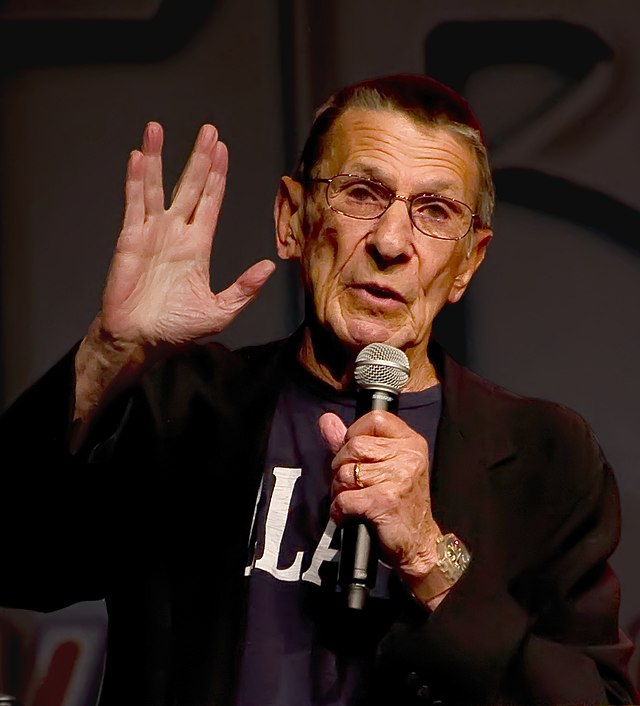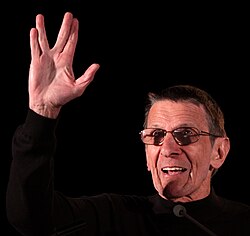Vulcan salute
Contributors to Wikimedia projects
 Article Images
Article Images
The Vulcan salute is a hand gesture popularized by the 1960s television series Star Trek. It consists of a raised hand with the palm forward and the thumb extended, while the fingers are parted between the middle and ring finger.

Description
The Vulcan salute was invented by Leonard Nimoy, who portrayed the half-Vulcan character Mr. Spock on the original Star Trek television series. A 1968 New York Times interview described the salute as a "double-fingered version of Churchill's victory sign. Nimoy said in that interview that he "decided that the Vulcans were a 'hand-oriented' people".[1]
The salute first appeared in 1967 on the Star Trek second season opening episode, "Amok Time". Among other things, the gesture is known for being difficult for certain people to do properly without practice or the covert pre-positioning of the fingers, and actors on the original show reportedly had to position their fingers off-screen with the other hand before raising their hand into frame. This difficulty may stem from variations in individuals' manual dexterity. Its reputation is parodied in the motion picture Star Trek: First Contact when Zefram Cochrane, upon meeting a Vulcan for the first time in human history, is unable to return the Vulcan salute gesture and instead shakes the Vulcan's hand.
In his autobiography I Am Not Spock, Nimoy wrote that he based it on the Priestly Blessing performed by Jewish Kohanim with both hands, thumb to thumb in this same position, representing the Hebrew letter Shin (ש), which has three upward strokes similar to the position of the thumb and fingers in the salute. The letter Shin here stands for El Shaddai, meaning "Almighty (God)", as well as for Shekinah and Shalom. Nimoy wrote that when he was a child, his grandfather took him to an Orthodox synagogue, where he saw the blessing performed and was impressed by it.[2]
The symbol became so well-known that in June 2014 it was added to version 7 of the Unicode standard as U+1F596 🖖 RAISED HAND WITH PART BETWEEN MIDDLE AND RING FINGERS, [3][4] and the White House referenced it directly it in its statement on Leonard Nimoy's death, calling it "the universal sign for 'Live long and prosper.'"[5] NASA astronaut Terry W. Virts posted the salute without commentary on his Twitter feed from the International Space Station with the Earth as the background. [6]
"Live long and prosper"
The accompanying spoken blessing, "live long and prosper", ("dif tor heh smusma" in the Vulcan language as spoken in Star Trek: The Motion Picture) also appeared for the first time in "Amok Time", scripted by Theodore Sturgeon.[7] The less-known reply is "peace and long life", though it is sometimes said first, with "live long and prosper" as the reply. This format is similar to common Middle Eastern greetings (Salaam alaykum in Arabic and Shalom aleikhem in Hebrew), meaning "peace be upon you", and its reply, "upon you be peace". An ancient Egyptian blessing "ankh wedja seneb", while its verbatim translation is uncertain, uses the three symbols "life", "prosperity" and "health"; it has been translated as "may he live, be prosperous, be healthy."[8] William Shakespeare's Romeo and Juliet contains the line, "Live and be prosperous: and farewell good fellow.", spoken by Romeo to Balthasar, his friend and servant.[9][10] The benediction "live and prosper" is attributed to the 18th-century organized crime figure Jonathan Wild in his 1725 biography written by "H.D.," possibly a pseudonym for Daniel Defoe.[11] The phrase 'live long' first appeared in print in 1957 in Eric Frank Russell's science fiction classic Wasp where it was used both as a greeting and as a farewell by the race of aliens the Sirians.[citation needed]
See also
- The Priestly Blessing of Judaism, the source for the Vulcan salute hand gesture.
- Rock-paper-scissors-lizard-Spock, a parody of Rock-paper-scissors which utilizes the gesture.
- Pro-wrestlers Big Van Vader and Big Daddy V used the Vulcan salute to taunt their opponents and fans.
- The gesture was also used as a greeting by the alien character "Mork" in the 1970s television show Mork & Mindy. The gesture was accompanied by the phrase, "Nanu-nanu". In the show it is used as a handshake, with the thumb remaining positioned against the side of the palm.
- The Nerdfighter "gang sign" is made by crossing one's arms in front of one's face as in the Jolly Roger flag, with both hands forming the Vulcan gesture.
References
- ^ Diehl, Digby (August 25, 1968). "Girls All Want To Touch The Ears". The New York Times. p. 173. Retrieved February 27, 2015.
- ^ "Leonard Nimoy: 'Star Trek' fans can be scary". Hero Complex. Los Angeles Times. May 11, 2009. Retrieved May 14, 2009.
- ^ West, Andrew (October 20, 2013). "What's new in Unicode 7.0?". Retrieved January 17, 2014.
- ^ http://arstechnica.com/gadgets/2014/06/unicode-7-0-introduces-2834-new-characters-including-250-emoji/
- ^ /2015/02/27/statement-president-passing-leonard-nimoy
- ^ /astronaut-pays-perfect-tribute-to-spock-from-outer-space
- ^ "Theodore Sturgeon". Gary Westfahl's Bio-Encyclopedia of Science Fiction Film. The SF Site. Retrieved April 28, 2007.
- ^ (Gardiner, Alan (1957). Egyptian Grammar. Griffith Institute, Ashmolean Museum, p. 239)
- ^ Act V. Sc iii. Romeo and Juliet. Shakespeare, William. Folger Shakespeare Library Edition. 1992.
- ^ "Romeo and Juliet, Act V, Scene 3 :|: Open Source Shakespeare". Opensourceshakespeare.org. Retrieved July 3, 2012.
- ^ H.D. (possibly Daniel Defoe). Originally published in 1725 by T. Warner in London. The Life of Jonathan Wild, from His Birth to His Death. Ann Arbor: University of Michigan. 2007 [1725]. p. 24. Retrieved August 8, 2014.
External links
- Vulcan salute at Memory Alpha
- Gershom, Yonassan (2009). Jewish Themes in Star Trek. Archived from the original on July 5, 2012. Retrieved February 28, 2015. A page by Rabbi Yonassan Gershom, with photos and diagrams of how the Salute forms the Hebrew letter Shin, the use of the Blessing Hands gesture on Jewish gravestones and jewelry, etc.
- Video: Leonard Nimoy on the Jewish provenance and cultural impact of the Vulcan salute (Yiddish Book Center Wexler Oral History Project)